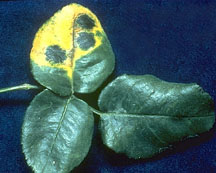
Rose black spot, caused by the fungus Diplocarpon rosae, is the most common cause of defoliation of landscape roses in Eastern United States. The disease is less of a problem in greenhouses where relative humidity can be carefully controlled. Susceptible landscape roses must be sprayed frequently with fungicides to keep the disease under control. Fortunately for rose growers, some of the newer cultivars and hybrids have resistance to this disease.
Symptoms
 Fig. 1. Leaf symptoms of rose black spot. (Photo by R. C. Lambe) |
Small, round spots, ranging in size from 1/16" to 1/2" in diameter, appear on the upper sides of leaves. Leaf tissue adjacent to the spot turns yellow. Whole leaves eventually turn yellow and fall prematurely. Black spot can be distinguished from other leaf spot diseases of rose by the generally fringed margins and the darker and consistently black color of the leaf spots. Similar spots may appear on petioles and fruit. Raised, reddish-purple spots may also appear on canes. If black spot is left uncontrolled and early defoliation occurs, bushes are weakened and cane dieback the following spring may be severe. Weakened plants may continue to die even after the plants leaf out.
Disease Cycle
During dormancy the fungus survives in infected canes and fallen leaves. Spores are spread to the highly susceptible, young, unfolding leaves in spring by splashing water. Infection takes place only when water remains on the leaves for seven or more hours. Therefore, the disease is most serious in regions of high rainfall and high humidity. Because the fungus tolerates a wide range of temperatures, symptoms can continue to develop all season long if moisture is adequate.
Control
Cultural Control
A preventative program for black spot should begin in the fall with a thorough sanitation program. Diseased leaves on the ground should be raked and burned or removed. All diseased canes should be pruned back to healthy wood. These practices will reduce the amount of overwintering fungus. During the growing season, overhead irrigation, which prolongs leaf wetness, should be avoided. If plants are overhead irrigated, watering should be done in the morning rather than the afternoon so that leaves dry quickly.
Chemical Control
Fungicides registered for black spot control should be applied preventatively to susceptible roses starting in spring before the new leaves become spotted. From this time through frost, the plants should never pass through a rainy period without a protective coating of fungicide on the leaves. Fungicides registered for black spot control include propiconazole (e.g. Banner), thiophanane methyl (e.g. Cleary 3336), chlorothalonil (e.g. Daconil 2787), mancozeb (e.g. Fore, Dithane, or Maneb), thiophanate methyl + mancozeb (e.g. Zyban), trifloxystrobin (e.g. Compass) and myclobutanil (e.g. Systhane). Most of these fungicides can be sprayed at 7-10 day intervals when rains are infrequent. During rainy weather, it may be necessary to spray the plants more frequently. Details on rates and timing of application can be found the current Virginia Pest Management Guide for Home Grounds and Animals (VCE Publication 456-018) or the Virginia Pest Management Guide for Horticultural and Forest Crops (VCE Publication 456-017), http://www.ext.vt.edu/pubs/pmg/. For information on the proper use of pesticides and fungicides, refer to any current VCE pest management guide.
Resistance
The most effective way to prevent black spot is to plant roses that have resistance to the disease. Most roses get black spot to some degree, but roses that have been bred for resistance to this and another common disease of roses, powdery mildew, will require less maintenance than those that are known to be susceptible to these diseases. Some hybrids and cultivars that showed good to excellent resistance to both black spot and powdery mildew in a 1990 survey in Maryland are listed below (Table 1). Note that the degree of resistance exhibited by these roses in a given landscape may vary somewhat depending on local environmental conditions.
| Table 1. Roses with good to excellent resistance to black spot and powdery mildew | ||||||
| Hybrid Teas Canadian White Star Chablis Duet Electron Elmhurst Lady Lady Rose Lady X Maid of Honor Mikado Miss All American Beauty Modern Art Mon Cheri Nantucket Olympiad Otto Miller Pascale Polarstern Red Devil Voo Doo Wimi | | Grandifloras Love Prima Donna Floribundas Koricole Lavaglut Playboy Playgirl Simplicity Sun Flare Traumerei | | Miniatures Always A Lady Anytime Black Jade Centerpiece Cinderella Cuddles Ginny Green Ice Heartland Kathy Robinson Mary Bell Old Glory Queen City Red Flush Singles Better Watercolor | | Shrub Roses Alba Meidiland Albo Semi-plena Blanc Double de Coubert Bonica Frau Dagmar Hartopp Linda Campbell Pink Meidiland Roseraie de l'Hay Rugosa alba Scarlet Meidiland Topaz Jewel |
No comments:
Post a Comment